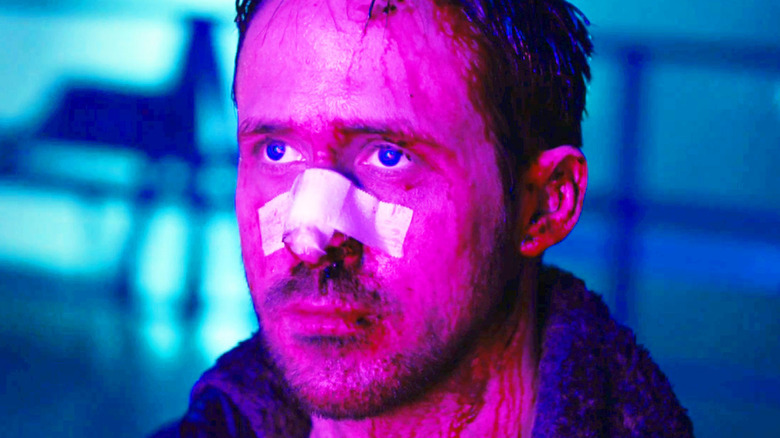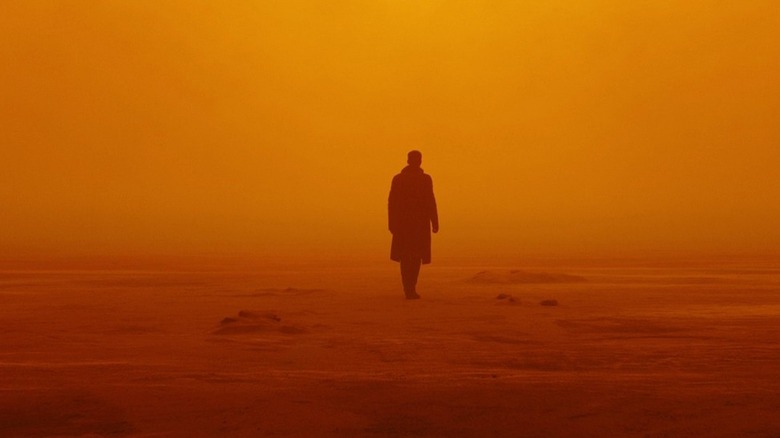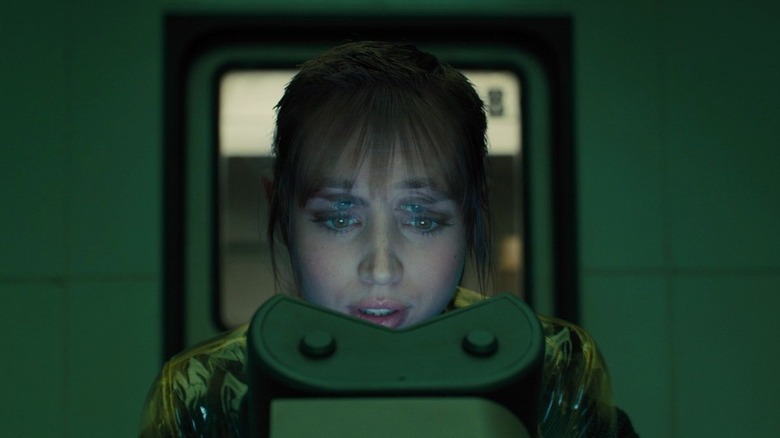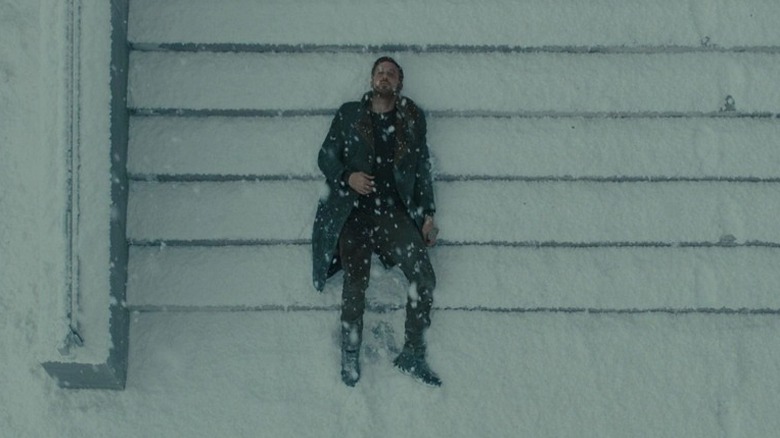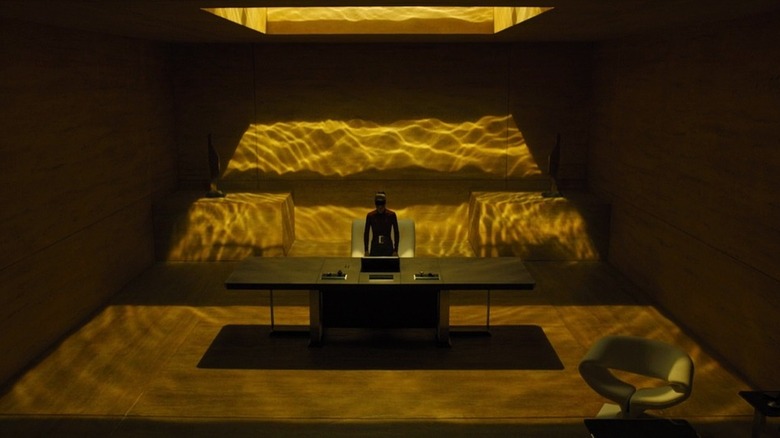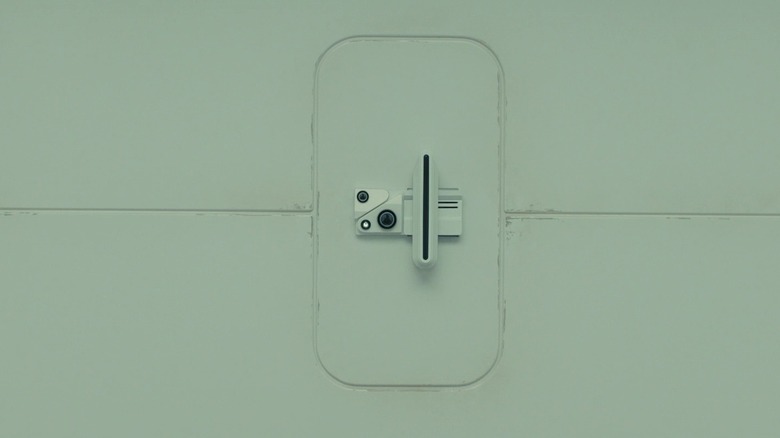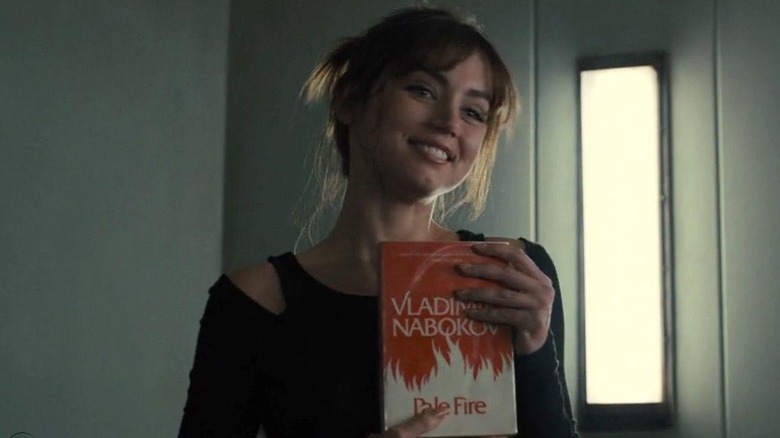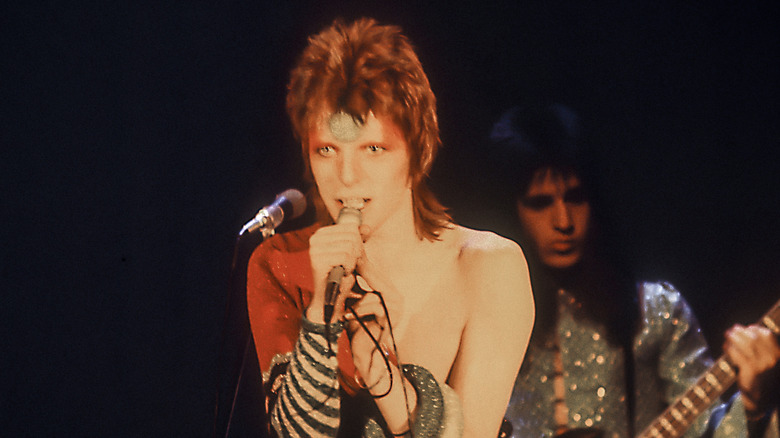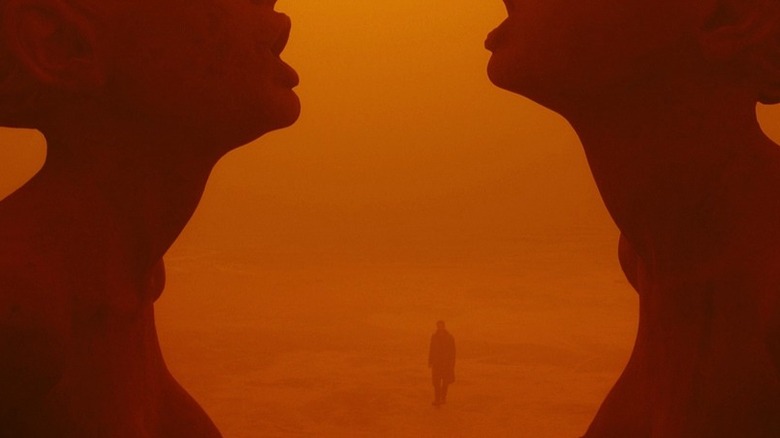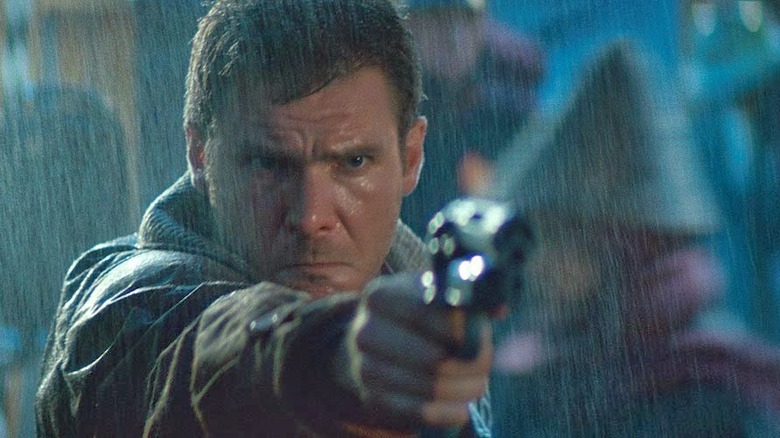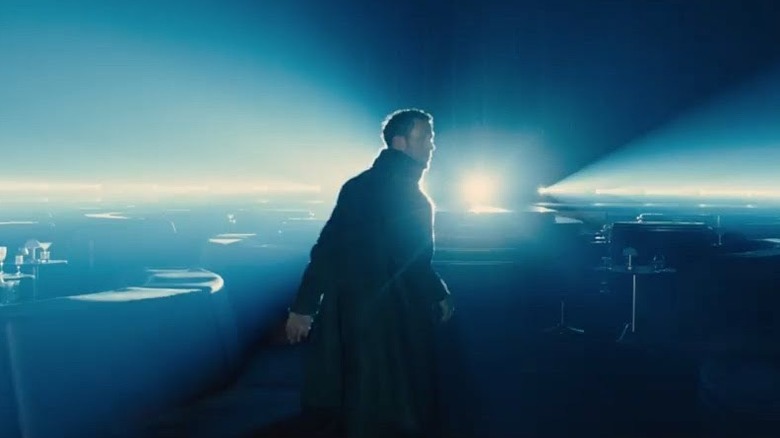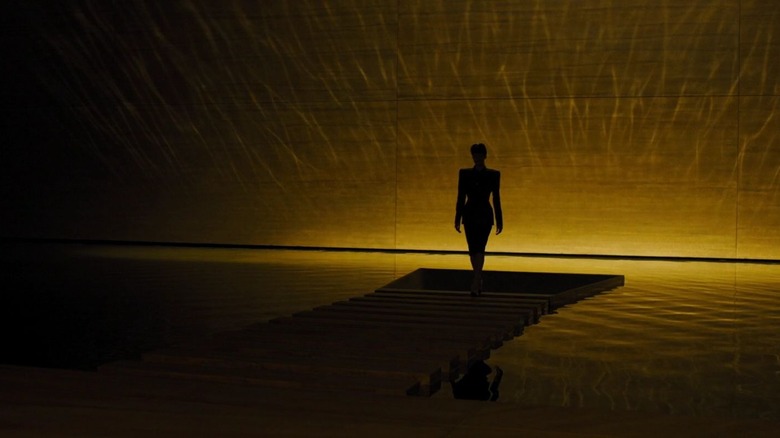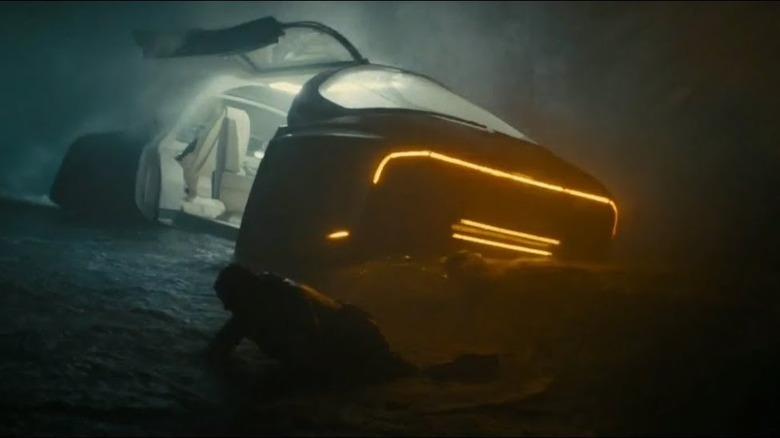The Untold Truth Of Blade Runner 2049
Years before "Dune," Denis Villeneuve got his hooks into another science fiction cult favorite with his sequel to "Blade Runner." Ridley Scott's 1982 classic was too odd and original for most viewers, guaranteeing a box office flop that slowly built a fanatical following over time. So it shouldn't surprise anyone that by taking Scott's creations to even stranger places, "Blade Runner 2049" suffered the same fate. And for the same reasons, it's developing at least as devoted a cult.
Watching "Blade Runner 2049" makes it obvious why it mesmerized so many viewers and alienated so many more. While its story of Ryan Gosling as next-generation replicant-hunter K discovering a secret replicant child hits many of the classic Chosen One beats (or at least seems to), the way it's told is like very little else in the movies.
Where most science fiction movies light up the screen with laser light shows, "2049" takes place in flickering shadows. Where most futures are cold and sterile, or, as the War Boys might call it, "shiny and chrome," the world of "2049" replaces the original's icy blueness with a warm shade of amber you rarely see onscreen. As action movies become more frenetic, "2049" stretches its story out over nearly three hours to create a dreamy, druggy atmosphere, like watching "Star Wars" at half speed.
A movie as singular as this is always going to have some equally singular stories playing out behind the scenes. Here are just a few of the best ones.
Blade Runner 2049 began as a short story from the original film's screenwriter
The biggest challenge in creating "Blade Runner 2049" was finding a new story within the classic movie's world. So the producers went straight to the source — original screenwriter Hampton Fancher. Originally hoping to act, Fancher fell in love with Philip K. Dick's novel "Do Androids Dream of Electric Sheep?" and set to work molding it into what would eventually become "Blade Runner."
Wired reports he fell out with Ridley Scott, who brought in David Peoples to rewrite the script. So when he got a call from Scott to return to the world they'd created, he joked, "Oh, you finally hit the bottom of the barrel."
Fortunately, Fancher already had some of the necessary work under his belt. He'd written a short story whose protagonist seemed like the perfect character to succeed Harrison Ford's Rick Deckard, and with a little polishing, K and his journey began to coalesce into the form he and co-writer Michael Green turned into "Blade Runner 2049."
The top-secret script hid under some creative codenames
A new "Blade Runner" movie for the first time in over three decades was almost guaranteed to attract a media circus. So to keep the details of the sequel secret, Wired reports Green and Fancher avoided using its actual name. This is common practice in Hollywood, dating back at least to "Return of the Jedi," aka "Blue Harvest."
But if that name was chosen to deflect attention by being as boring as possible, the codename for "2049" was intriguing in its own right: "Acid Zoo." The story behind the name is more intriguing still. Green credits the inspiration to one of Fancher's favorite true-life stories, the time he took LSD and ended up spending all day staring at gorillas. It would be fitting for a movie where LA's battered by apparently acidic rain, where the murky visuals and trippy images like Mackenzie Davis and Ana De Armas as a four-handed composite character are as druggy as anything in a Hollywood movie since the acid heyday of the '70s.
But reporters were too spoiler-hungry for one codename to be enough — Green tells Monsters and Critics the original shell name was "Queensboro," after the bridge connecting the collaborators' respective homes in Brooklyn and Manhattan. But that wasn't enough to keep the snoopers away long, so Fancher simply moved the script across the river to "Triborough."
Two cities make a difference between Blade Runner and its sequel
With a story in place, and after "Blade Runner" superfan Christopher Nolan turned down the job, "2049" found its director in French-Canadian filmmaker Denis Villeneuve. Best known at the time for psychological thrillers like "Sicario" and "Enemy," Villeneuve had recently dipped his toe into science fiction with the Amy Adams-starring, Oscar-nominated "Arrival." That was far from his only credential for the assignment, though: Villeneuve told Entertainment Weekly the original "gave birth to my desire to become a director."
His affection for Scott's vision didn't keep Villeneuve from adding his own, though. One of the most striking differences is the weather report from Neo-Los Angeles. While the original is drenched in an oppressive layer of rain, it's turned much wintrier by 2049, with an equally oppressive blanket of snow.
Villeneuve explains in the documentary "Designing the World of 'Blade Runner 2049,'" "The first movie was more, like, inspired by bad days in London, where Ridley's coming from. Me, I'm coming from Montreal. So, it's like snow, and sludge, and the cold."
Gosling elaborated to Vice on what a difference that made: "The first thing [Villeneuve] said was, 'In my 'Blade Runner,' it snows. I'm Canadian, and I need to work in an environment that I understand and that I know is real and truthful to me.' ... And I was immediately relieved. And I thought, okay, this guy's got it."
Ryan Gosling needed time to get used to the sets
Another way "Blade Runner 2049" stands out from its science fiction peers is the relatively low-tech, highly tactile approach it took to the sets. While your average movie future is mostly filmed in one green-screened room that can stand in for any number of locations, Villeneuve's crew took the time to find and build their settings in the three-dimensional world. The grimy, industrial orphanage where K tracks the replicant child was filmed in a Soviet-era power plant outside Budapest. Other sets were built life-size from scratch.
Many of the cast and crew talk about how much interacting with their environments enhanced the film's performances, but for Gosling, it posed a challenge. "It was really impressive," he says in the "Designing the World" documentary. "It felt necessary for me to spend as much time there as possible so that I wasn't impressed during the scene so that I was able to react as though I'd never known anything else."
Not everyone was able to contain themselves. Dave Bautista says, "The first day I showed up ... I went to the big water tank. And I'm like a big kid when it comes to this stuff, so I was just in awe of everything."
The Baseline scene was born out of an acting warmup
"Blade Runner 2049" is missing one of the original's most iconic elements: the Voight-Kampff Empathy Test used to distinguish humans from replicants. But like many pieces of the 1982 version, it echoes through "2049" in an even stranger form as the Baseline test K has to take after returning to headquarters. Its purposes and how it accomplishes them are more indistinct — dreadfully indistinct, to paraphrase the test itself. It seems like it would fit in better in experimental theater than a would-be franchise blockbuster, as an unseen interrogator barks out poetry at K, interrupting himself to repeat individual words, have K repeat them, or free-associate questions based on them.
That's all Gosling. Villeneuve told Den of Geek the test lacked the necessary violence until Gosling "came up with this process that actors use to learn Shakespeare, where you say a word, then they repeat the word, and then someone would ask a question about that word ... so they remember the word forever."
It's a tense scene, and "The Art and Soul of Blade Runner 2049" reveals that the crew originally tested just how long they could keep that tension up. Gosling wrote and performed his own script for an early draft of the scene that lasted eight minutes. While most of it was lost in the edit, that long take was still essential to the film's development. "I said to Ryan Gosling, That's exactly the kind of movie I want to make," Villeneuve says. "That's the exact kind of tension, brutality, aggression I want."
The Baseline scene has literary roots
"A system of cells interlinked within/Cells interlinked within cells interlinked/Within one stem. And dreadfully distinct." The text of the Baseline test will be baffling to most viewers, but the most literate ones may hear something familiar.
It's lifted verbatim from Vladimir Nabokov's 1962 experimental novel "Pale Fire." The Russian-American author is best-known for his exploration of the mind of a child molester in "Lolita," as well as a long list of other plays, poems, novels, and short stories.
Nabokov presents "Pale Fire" as a narrative poem by John Shade, with annotations by Charles Kinbote, who claims to be Shade's friend and interpreter. But his notes suggest they had a much less healthy relationship and Kinbote himself has a much looser grip on reality than he claims.
The name may sound familiar even if "Blade Runner" is your only exposure to Nabokov's book — it's the one Joi hands K when she suggests he read to her. Is this K's version of cramming for a test? Or has the LAPD sadistically turned one of his few sources of relief against him? No wonder he tries to get out of it by responding, "I thought you hate it when I read to you."
David Bowie was in line to play Wallace
"Blade Runner 2049" drew controversy for casting Jared Leto as villain Niander Wallace, not long after his interpretation of "method acting" for his bit part as the Joker in "Suicide Squad" seemed to mostly consist of allegedly abusing his costars. Whatever its moral dimensions, the casting worked surprisingly well on the creative level. Leto wisely stays offscreen for most of the film, and his reputation as a creep only enhances the creepiness of his performance. But it's still hard not to wish we could see the alternate version where the role went to a true icon.
David Bowie was Denis Villeneuve's first choice for the replicant manufacturer with delusions of divinity. In fact, he felt Bowie's presence was essential to the film because of his pioneering combination of pop star glamour and pessimistic futurism. Villeneuve told Dazed Digital, "The idea of David Bowie came at the beginning. I'm sure Ridley Scott would not agree with what I'm saying right now, but for me he was 'Blade Runner' before its time."
Tragically, "Blade Runner 2049" came just after Bowie's time. Before the studio could approach Bowie with the role, he died of liver cancer.
The loss stunned Villeneuve, and it took him a month to find a suitable replacement. Whether or not you think he succeeded, it's hard to imagine anyone living up to what the Thin White Duke might have done with the role.
The original production designer returned
As much as Harrison Ford or Sean Young, the star of the original "Blade Runner" is the futuristic Los Angeles designed by Syd Mead, that defined the look of cyberpunk for decades to come. That gave the "2049" crew plenty to work with, but the story also required them to expand the original film's world. After discovering a wooden horse from his childhood memories he believes will lead him to his real father, K leaves LA for the radioactive ruins of Las Vegas. When it came time to design a second city from the world of "Blade Runner," who could Villeneuve trust more than the architect behind the first one?
Mead took advantage of tools he didn't have in 1982, telling Fast Company he downloaded images of modern Vegas from Google Street View and overlaid his vision on top of them. If anything, he topped himself. The ruins of Vegas are among the most memorable images in either "Blade Runner," with their monumental statues crumbling to reveal their chicken-wire skeletons, half-buried in the sand like something out of "Ozymandias," and made even more haunting by cinematographer Roger Deakins turning everything a blinding shade of orange.
The studio tracked down a collector to recreate Deckard's blaster
"Blade Runner 2049" holds back the return of Harrison Ford until the last hour. But when we finally catch up with him, the crew pulls out all the stops to do him justice. That means Ford is once again packing his classic blaster, and the prop department went to great lengths to make sure they got it just right.
That meant tracking down one of the models Ford had carried back in 1982. Wired reports that by the time filming began in 2016, the original had been auctioned off to a private collector. ("I won't embarrass him by telling how much he paid," property master Doug Harlocker told Vice.) The crew struck a deal to fly the blaster to their studio in LA, where they took hundreds of photos and measurements to reverse-engineer three new models. This meant taking the same real gun and rifle models that had gone into the original props, stripping them for parts, and reassembling them into their futuristic shape, then adding an extra 30 years of wear and tear to complete the effect.
Harrison Ford almost knocked out Ryan Gosling
Harrison Ford has spent the past several decades making his name as one of the biggest tough guys in the movies. Even though he was nearly 75 when he made "Blade Runner 2049" and had broken his leg on the set of "The Force Awakens" a few years earlier, he could still hold his own. Maybe a little too much for his own good.
In the most memorable action scene in "2049," Ford and Gosling get into a punchout in the abandoned theater of a Vegas casino, lit only by flickering holograms of long-dead performers and interrupted by stuttering snatches of music. It all looks bone-crunchingly real, but ever since the early days of theater, actors have known how to cheat angles and pull punches so what looks painful really isn't. Most of the time.
For this scene, though, Ford landed a good solid punch right in Gosling's face. If you want to know how hard it landed, just look at Gosling's dazed face in this image – but don't miss Ford's look of horrified realization in the background. Gosling broke the story to GQ, including one memorable detail: "When it was over, they brought ice for my face, and Harrison pushed me out of the way and stuck his fist in the ice."
It took a dual performance to bring Rachael back to life
Harrison Ford isn't the only star of the classic "Blade Runner" to return for "2049." His love interest, Rachael, as played by Sean Young, is integral to the plot as the first replicant to give birth. But it seems like it will be a strictly offscreen role, since she died in the process and the plot kicks off with K discovering her bones.
But then, in one shocking moment, Wallace hopes to get Deckard to reveal his secrets by bringing Rachael back from the dead. That's when Sean Young appears looking, give or take some uncanny CGI, just like she did in 1982.
Computer trickery doesn't tell the whole story, though. No one but Young could convincingly play Rachael, and Creative Bloq reveals she recorded her lines in the studio, where the crew used motion capture to record not just her voiceover, but her facial movements too. But Rachael also needed to move as if she hadn't aged in the past 30 years, so Young's performance was overlaid with Loren Peta's. Peta acted her scene with motion capture markers to overlay Young's face over hers, then read through her lines in the same process Young used to create the composite performance in the finished film.
Luv's license plate is a barcode with a hidden message
Like any good production designers, the "Blade Runner" crew fleshed out their world with subtle details and kept themselves and obsessive viewers amused with a series of hidden messages. Many of them will be obvious with enough attentiveness, but at least one requires some fluency in computer-ese.
In the climax, archvillain Luv (Sylvia Hoeks) drives Deckard out to the space port where she'll have access to more advanced interrogation tools somewhere offworld. They take their trip in a modified version of the iconic "spinner," Deckard's flying car from the original. Look closely, and you might see the license plate is appropriately futuristic — no letters or numbers, just the vertical lines of a barcode.
That may not sound like the medium for a vanity plate, but the film's designers found a way. "'Blade Runner 2049': Interlinked — The Art" reveals that if you put the license plate through a barcode reader, you'd get the name Philip K. Dick. Dick had a long and influential career in the science fiction field, bringing unprecedented, mind-bending concepts and social commentary to the genre in classics like "Ubik," "Flow, My Tears, the Policeman Said," and "The Three Stigmata of Palmer Eldritch." His work has inspired TV series like "The Man in the High Castle" and movies like "Minority Report," "Total Recall," and, of course, "Blade Runner." It's a small tribute to the man who started it all, but we like to think he'd appreciate it just the same.
